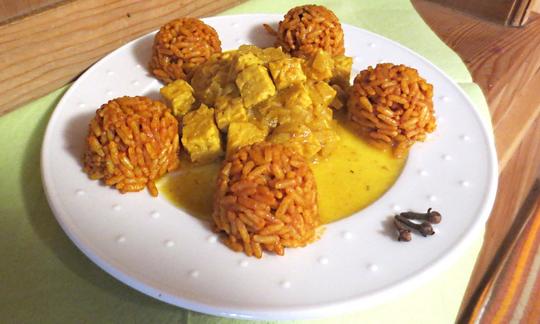curry-orange tempeh with spiced rice
vegan
Ingredients (for servings, )
| For the spiced rice | |
|---|---|
| 1 tsp | Rapeseed oil (canola, HOLL oil, kernel oil), cold pressed?, organic? (0.16 oz) |
| 3 ½ oz | Long grain rice, white, raw (organic?) |
| 3 | Cloves, whole (raw?, organic?) (0.01 oz) |
| 3 | Cardamom (cardamom, cardamom, cardamom) (0.02 oz) |
| ⅓ tsp | Turmeric (saffron root), ground, raw (organic?) (0.04 oz) |
| ⅓ tsp | Paprika powder, hot (raw?, organic?) (0.03 oz) |
| 300 ml | Drinking water, raw (organic?) (11 oz) |
| 2 tbsp | Tomato paste, unsalted (organic?, raw?) (1.1 oz) |
| 2 dash | Table salt (table salt, raw?, organic?) (0.03 oz) |
| For the orange tempeh | |
| 7 ⅓ oz | Tempeh (raw?, organic?) |
| 2 | Onions, raw (organic?) (7.7 oz) |
| 2 tbsp | Peanut oil (organic?, raw?) (0.95 oz) |
| 100 ml | Drinking water, raw (organic?) (3.5 oz) |
| 1 tsp | Paprika powder, hot (raw?, organic?) (0.08 oz) |
| 1 tsp | Curry powder (organic?, raw?) (0.07 oz) |
| 3 | Oranges, raw, (organic?) (14 oz) |
Equipment
- skillet (frying pan)
- stove
- citrus juicer (lemon squeezer)
Type of preparation
- cook
- fry
- chop or grind
- sauté
- squeeze
- sauté
- deglaze
- remove the skin
- reduce (thicken)
Preparation
For the spiced rice
Pour vegetable oil into a medium-sized pan. Add the (uncooked) rice with cloves, cardamom pods, turmeric and paprika powder and heat on low heat for about 5 minutes.Add all the water, stir in tomato paste and salt and simmer on medium heat for 10-15 minutes.
Check every now and then whether the rice is cooked and whether there is still enough water in the pan - the water boils away more quickly than in a pot and the rice can easily stick.
For the orange tempeh
Meanwhile, dice the tempeh (about 1-2 cm in diameter, depending on your preference), peel and roughly chop the onions. Heat the vegetable oil and add the tempeh as soon as the oil is hot. Fry for about 5 minutes on all sides until lightly golden.Add onions and mix well. Fry on medium heat for about 5 minutes.
Pour water over the onions and tempeh, add the paprika and curry powder, cover and simmer over medium heat for 10 minutes. In the meantime, you can squeeze the oranges.
The water should now be almost evaporated. Now deglaze the tempeh and onions with the orange juice and simmer for another 5-7 minutes on a low heat until the orange juice thickens or reduces.
serving
Arrange the spiced rice and orange tempeh on a plate and add spice pastes such as sambal olek or chutney as desired.
|
Nutritional Information per person
Convert per 100g
|
2000 kcal | |
|---|---|---|
| Energy | 674 kcal | 33.7% |
| Fat/Lipids | 28 g | 39.6% |
| Saturated Fats | 5.2 g | 26.2% |
| Carbohydrates (inc.dietary fiber) | 86 g | 31.9% |
| Sugars | 25 g | 28.1% |
| Fiber | 9.2 g | 36.8% |
| Protein/Albumin | 28 g | 56.1% |
| Cooking Salt (Na:190.6 mg) | 484 mg | 20.2% |
| Essential micronutrients with the highest proportions | per person | 2000 kcal | |
|---|---|---|---|
| Vit | Vitamin C (ascorbic acid) | 116 mg | 145.0% |
| Min | Manganese, Mn | 2.5 mg | 123.0% |
| Prot | Tryptophan (Trp, W) | 0.28 g | 112.0% |
| Prot | Threonine (Thr, T, irreversibly transaminated) | 1.0 g | 109.0% |
| Min | Copper, Cu | 0.91 mg | 91.0% |
| Prot | Isoleucine (Ile, I) | 1.1 g | 91.0% |
| Fat | Linoleic acid; LA; 18:2 omega-6 | 9.1 g | 91.0% |
| Prot | Valin (Val, V) | 1.3 g | 79.0% |
| Prot | Phenylalanine (Phe, F) | 1.2 g | 78.0% |
| Prot | Leucine (Leu, L) | 1.8 g | 76.0% |
Detailed Nutritional Information per Person for this Recipe
The majority of the nutritional information comes from the USDA (US Department of Agriculture). This means that the information for natural products is often incomplete or only given within broader categories, whereas in most cases products made from these have more complete information displayed.
If we take flaxseed, for example, the important essential amino acid ALA (omega-3) is only included in an overarching category whereas for flaxseed oil ALA is listed specifically. In time, we will be able to change this, but it will require a lot of work. An “i” appears behind ingredients that have been adjusted and an explanation appears when you hover over this symbol.
For Erb Muesli, the original calculations resulted in 48 % of the daily requirement of ALA — but with the correction, we see that the muesli actually covers >100 % of the necessary recommendation for the omega-3 fatty acid ALA. Our goal is to eventually be able to compare the nutritional value of our recipes with those that are used in conventional western lifestyles.
| Essential fatty acids | per person | 2000 kcal |
|---|---|---|
| Linoleic acid; LA; 18:2 omega-6 | 9.1 g | 91.0% |
| Alpha-Linolenic acid; ALA; 18:3 omega-3 | 0.50 g | 25.0% |
| Essential amino acids | per person | 2000 kcal |
|---|---|---|
| Tryptophan (Trp, W) | 0.28 g | 112.0% |
| Threonine (Thr, T, irreversibly transaminated) | 1.0 g | 109.0% |
| Isoleucine (Ile, I) | 1.1 g | 91.0% |
| Valin (Val, V) | 1.3 g | 79.0% |
| Phenylalanine (Phe, F) | 1.2 g | 78.0% |
| Leucine (Leu, L) | 1.8 g | 76.0% |
| Lysine (Lys, K, irreversibly transaminated) | 1.2 g | 65.0% |
| Methionine (Met, M) | 0.31 g | 33.0% |
| Vitamins | per person | 2000 kcal |
|---|---|---|
| Vitamin C (ascorbic acid) | 116 mg | 145.0% |
| Vitamin B9, B11 (Folate, as the active form of folic acid) | 111 µg | 56.0% |
| Vitamin B6 (pyridoxine) | 0.62 mg | 44.0% |
| Vitamin B2 (Riboflavin) | 0.54 mg | 38.0% |
| Vitamin E, as a-TEs | 4.4 mg | 36.0% |
| Vitamin B1 (Thiamine) | 0.35 mg | 32.0% |
| Vitamin B3 (Niacin) | 4.8 mg | 30.0% |
| Vitamin B5 (Pantothenic acid) | 1.5 mg | 25.0% |
| Vitamin B7 (Biotin, ex vitamin H) | 9.4 µg | 19.0% |
| Vitamin A, as RAE | 85 µg | 11.0% |
| Vitamin K | 6.6 µg | 9.0% |
| Vitamin B12 (Cobalamin) | 0.08 µg | 3.0% |
| Essential macroelements (macronutrients) | per person | 2000 kcal |
|---|---|---|
| Potassium, K | 1'209 mg | 60.0% |
| Phosphorus, P | 407 mg | 58.0% |
| Magnesium, Mg | 140 mg | 37.0% |
| Calcium, Ca | 252 mg | 32.0% |
| Sodium, Na | 191 mg | 24.0% |
| Essential trace elements (micronutrients) | per person | 2000 kcal |
|---|---|---|
| Manganese, Mn | 2.5 mg | 123.0% |
| Copper, Cu | 0.91 mg | 91.0% |
| Iron, Fe | 4.9 mg | 35.0% |
| Zinc, Zn | 2.3 mg | 23.0% |
| Selenium, Se | 10 µg | 19.0% |
| Fluorine, F | 144 µg | 4.0% |
| Iod, I (Jod, J) | 3.9 µg | 3.0% |
Curry orange tempeh with spiced rice is a hearty, filling dish reminiscent of Indian cuisine. It goes very well with chutney.
Tempeh is a fermented product made from whole soybeans that originally comes from Indonesia. During production, the washed, soaked and cooked soybeans are enriched or inoculated with a noble mold culture. The beans that are subsequently fermented produce a firm, compact mass with a slightly nutty, mushroomy taste. Tempeh is rich in protein, magnesium, calcium, iron and B vitamins. You can either use it directly or prepare it further. It is very versatile - from salads to sandwiches and Asian dishes to desserts.
There are tempeh products that are labeled "raw," but strictly speaking, these are not raw foods, as the soybeans are cooked during the manufacturing process. Some manufacturers use "raw" for products that have not been subjected to heat treatment for durability after fermentation, in this case revival using fungal cultures.
This food, incorrectly called "raw tempeh", is perishable due to its high water content, but it can be easily frozen and thus preserved for a long time.
Long grain rice: Long grain rice and short grain rice are the two largest varieties of the rice family. It is over six millimeters long and, unlike short grain rice, releases less starch during the cooking process and thus remains looser after preparation. The most well-known varieties include basmati and jasmine rice.
Peanut oil: Peanut oil is made from dried, peeled and then pressed peanuts. The cold-pressed quality is considered the most natural and has the most intense flavor, has a light to distinct peanut note and smells slightly fruity. The majority of peanut oils on the market are refined in order to achieve a uniform quality. This type of oil can no longer be described as raw due to the heating. Refined peanut oil is also almost tasteless. Peanut oil is ideal for frying and deep-frying due to its high heat stability. The shelf life is very good compared to many other oils - if stored in a sealed, cool and dark place, it will last up to 2 years.
Chutney as a complement: This recipe is based on Indian cuisine. Traditionally, rice dishes are served with a sauce and a chutney. Chutneys are seasoning pastes that are usually made from various fruits and vegetables, spices, etc. You can buy them ready-made or make them yourself. The production process is similar to that of jam production.
Oil: If you are allergic to peanuts, you can easily replace the peanut oil. In this case, you can use rapeseed oil, for example, or another oil of your choice.
Marinade: If you have time to prepare, you can marinate the fried tempeh cubes overnight or a few hours before preparation in a marinade made of onions, orange juice, paprika and curry powder and a little salt. Then simply put everything together in a pan and simmer over medium heat until the orange juice reduces.
Bomba rice: If you like short grain rice but prefer a variety with a lower starch content, we recommend the "Bomba rice" variety. Because of its lower starch content, it is looser and grainier after cooking.




